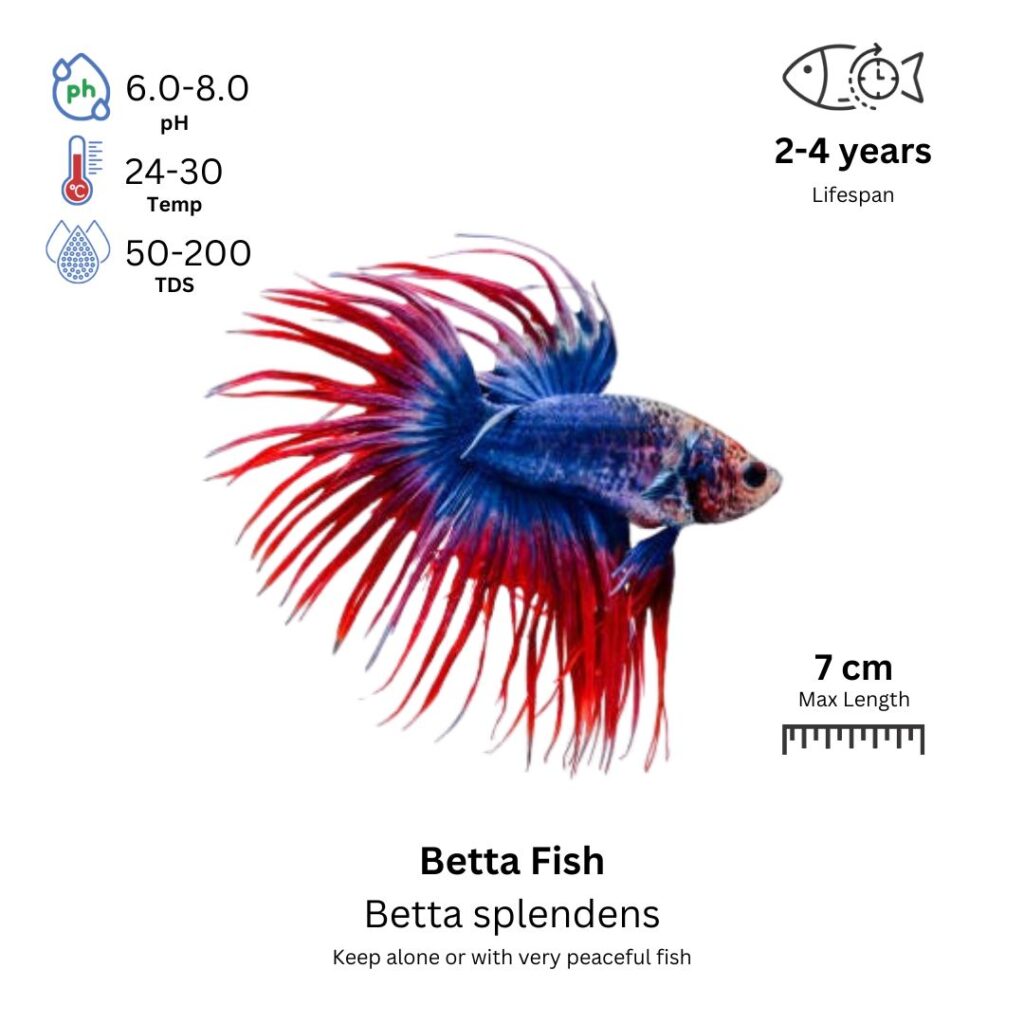Betta Fish
Betta splendens

Description
The Betta Fish, also known as the Siamese fighting fish, is famous for its vibrant colors and elaborate, flowing fins. Betta fish come in a variety of colors, including shades of red, blue, purple, and even white, with some having metallic or iridescent hues. They are known for their long, elegant fins and tails, especially in the more ornate variations. Bettas are relatively small, with males being more colorful and having larger fins than females. Despite their beautiful appearance, Betta fish are territorial and aggressive, particularly males, and should be kept alone or with peaceful tankmates in well-planned setups.
Habitat Origin
Native to Southeast Asia, particularly Thailand, Cambodia, and Vietnam. Bettas are commonly found in shallow, warm waters such as rice paddies, slow-moving streams, and ponds.
Aquarium
Ideal Number in Aquarium: 1 male per tank (males are territorial and aggressive towards each other). Females can be kept in groups if the tank is large enough, though care should be taken to avoid aggression.
Favorite Food

Bettas are carnivores and require a protein-rich diet. They thrive on high-quality pellets or flakes designed specifically for bettas, along with live or frozen foods like brine shrimp, daphnia, and bloodworms. A varied diet is essential for their health and vibrancy.
Behavior:
Bettas are known for their bold and curious personalities. Males are highly territorial and will often display aggressive behaviors, especially towards other males or similar-looking fish. They are also quite active and enjoy exploring their surroundings. While they can be kept with other peaceful species, care must be taken not to house them with fish that have long fins or brightly colored species, as this can trigger aggression.
Special Care:
Bettas require a heated tank with stable water temperatures. While they can survive in smaller tanks or bowls, this is not ideal for their long-term health. A tank with a filter and plants will provide a more natural environment, but they can live in tanks without filtration as long as the water is regularly changed. Bettas have labyrinth organs that allow them to breathe air, so it’s important to provide them with access to the water’s surface.
Compatibility with Other Fish:
Bettas are highly territorial and aggressive, particularly males. As a general rule, only one male Betta should be kept per tank. They can be kept with peaceful species like Corydoras, small tetras, and shrimp, but should not be housed with other male Bettas, fish with long fins, or other aggressive species. Female Bettas can sometimes be kept together in larger tanks, but it’s essential to monitor for aggression.
Breeding Tank Setup
A dedicated breeding tank is essential when breeding Betta fish due to the male’s territorial and aggressive nature. A 10-gallon tank (38 liters) provides sufficient space for interaction while allowing close monitoring. Maintain pH between 6.5–7.5, a temperature of 26–30°C (79–86°F), and hardness of 2–12 dGH. Use a sponge filter for gentle water flow and oxygenation without disturbing the bubble nest. Leave the substrate bare or use fine gravel, and add floating plants such as Java moss or Hornwort to provide cover for eggs and fry. Lighting should be moderate, using a 12-hour day/night cycle to reduce stress.
Breeder Selection
Prior to spawning, condition the Betta pair with a protein-rich diet of live or frozen brine shrimp, bloodworms, daphnia, and high-quality Betta pellets. Supplement with occasional blanched vegetables like peas for balanced nutrition. Perform weekly 25–30% water changes, and before introducing the female, conduct a larger 50% water change and slightly raise the temperature to mimic natural breeding triggers. This helps initiate bubble nest building and increases breeding receptiveness.
Spawning Behavior
Spawning generally occurs after the male builds a bubble nest at the water surface. Once introduced, the male courts the female with flaring and vibrant displays. Upon acceptance, the pair engage in an embrace, during which the female lays 100–200 eggs. These are carefully placed into the bubble nest by the male. After spawning, remove the female immediately to prevent aggression. The male guards the nest and cares for the eggs until they hatch.
Fry Hatching
Betta eggs hatch in 24–48 hours, with fry remaining in the bubble nest for 2–3 days, absorbing their yolk sacs. Once free-swimming (at around day 4), begin feeding infusoria, liquid fry food, or egg yolk solution. As they grow, introduce baby brine shrimp or microworms. Maintain excellent water quality with daily 10–20% water changes, stable temperature at 26–28°C, and avoid overfeeding, which can quickly degrade water quality.
Breeding Notes
Betta fish reach breeding maturity at 4–6 months, but the optimal breeding age is 6–12 months. Males are distinguished by their vibrant colors and long fins, while females are rounder and have shorter, duller fins. To prevent stress, avoid sudden environmental changes and never keep other fish in the breeding tank during the process. A calm, stable, and monitored environment greatly improves the chances of a successful spawn and healthy fry development.
